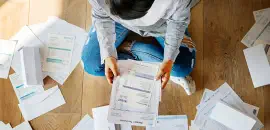

Key Takeaways
- Understanding what you owe is the foundation of any effective debt reduction plan.
- Building a realistic budget helps you prioritize payments and identify extra cash flow to tackle high-interest debts faster.
- Choosing a repayment strategy like the debt snowball or avalanche method can provide structure and motivation tailored to your financial goals.
- Increasing your income through side work or freelance opportunities may accelerate your debt payoff timeline.
- Reinforcing strong habits, like budgeting, saving for emergencies, and reviewing your progress, can help you stay out of debt for good.
Getting out of debt isn’t always easy, especially when interest payments, minimum payments, and credit card debt start to pile up. Whether you’re juggling a student loan, auto loan, car loan, or high APR credit card balances, the right plan can help you get back in control.
Here are actionable steps to help you get out of debt, including how to evaluate your debt load, budget more effectively, and decide when debt consolidation or professional help makes sense.
Step 1: Assess Your Current Debt Situation
The first step to debt reduction is knowing exactly what you owe. This means compiling all outstanding debts, such as your credit cards, student loan, auto loan, second mortgage, or home equity loan. Take note of your total balances, interest rates, and minimum payments.
List All Outstanding Debts
Pull your free credit report from one of the three major bureaus. This can help you catch any accounts you may have missed and monitor your credit utilization. Make a list that includes:
- Total balance owed
- APR or interest rate
- Minimum monthly payments
- Loan type (e.g., credit card, car loan, student loan)
Calculate Total Debt and Interest Rates
Once everything is listed:
- Add up your total debt by summing the outstanding balances across all accounts.
- Review interest rates (APR) on each loan or credit card.
- Estimate interest costs by multiplying each balance by its APR. This gives you an idea of how much each debt is costing you.
High-interest debts, such as credit card balances or payday loans, typically cost the most. Spotting these high-cost debts can help you prioritize repayment or consider tools like a balance transfer credit card or a debt consolidation loan to reduce interest and simplify payments.
Example:
- Credit Card A: $3,000 balance at 22% APR → Estimated annual interest = $3,000 x 0.22 = $660
- Credit Card B: $1,500 balance at 18% APR → Estimated annual interest = $1,500 x 0.18 = $270
- Auto Loan: $10,000 at 5% APR → Estimated annual interest = $10,000 x 0.05 = $500
In this case, focusing on Credit Card A may save the most in interest costs, especially if you can transfer the balance to a lower APR credit card.
Step 2: Build & Adjust Your Budget
Creating a realistic budget is a critical step in any debt reduction plan. Here's how to do it:
- Calculate your monthly income. Use your take-home pay (after taxes) from all sources.
- List your expenses: Break them down into variable costs (groceries, gas, entertainment) and fixed costs (rent, auto loan, insurance)
- Subtract total expenses from your income: This shows what you have available for debt repayment.
Example:
- Monthly income: $3,500
- Total expenses: $2,800
- Fixed: $1,900 (rent, utilities, car loan)
- Variable: $900 (food, gas, other spending)
- Leftover for debt payments: $700
If your expenses are greater than your income, look for areas to cut back. Cancel unused subscriptions, reduce dining out, or consider boosting income through side gigs. The goal is to cover minimum payments and apply extra funds toward high-interest debt.
Step 3: Choose a Repayment Strategy
Two of the most popular debt reduction strategies are the debt snowball and the debt avalanche method. Choose the one that matches your motivation and financial goals.
Debt Snowball Method
The debt snowball method involves paying off your smallest debt first while continuing to make minimum payments on your other accounts. Once that first debt is gone, you roll the amount you were paying into the next smallest balance, creating a “snowball” effect. This approach doesn’t prioritize interest rates. It’s about building momentum. The early wins from eliminating smaller debts may help you stay motivated and focused.
Debt Avalanche Method
The debt avalanche method, also known as the high-interest method, takes a more cost-efficient approach. You start by targeting the debt with the highest interest rate while making minimum payments on the rest. Once that’s paid off, you move to the next highest rate. This method typically reduces the total amount of interest you pay over time, which may help you get out of debt faster if you stick with it.
Step 4: Increase Your Income
Boosting your monthly income through freelance work, side hustles, or selling unused items can help you pay down debt faster. Even small amounts added to your monthly payments can make a difference.
Explore Part-Time Job Opportunities
If freelancing isn’t an option, consider flexible jobs like rideshare driving, pet sitting, or tutoring. Redirect that income toward your credit card debt or auto loan.
Consider Freelancing or Gig Work
Platforms like Fiverr or Upwork offer ways to turn your skills into extra cash, which you can allocate toward your debt repayment strategy.
Step 5: Consider Professional or Consolidation Support
Professional Help
If your debt feels overwhelming or you’re falling behind, a certified Credit Counselor may be able to help. Credit counseling services often start with a free consultation and may recommend a debt management plan tailored to your situation.
Credit Counseling Services
Credit counseling agencies can help negotiate lower interest rates and streamline payments through a debt management plan. This plan consolidates eligible debts into one payment plan, helping you stay organized and on track.
Debt Consolidation Options
Debt consolidation may help you combine multiple debts into a single, manageable payment. Consider the following:
- Debt consolidation loan: Ideal if you have a solid credit score and qualify for a lower interest rate.
- Balance transfer credit card: Often comes with a low or 0% introductory APR. Best for those with good credit.
- Home equity loan or second mortgage: Riskier options that use your home as collateral.
Step 6: Reinforce Good Financial Habits
Practice Strategic Budgeting
Creating and sticking to a well-organized budget gives you a clear view of your income, expenses, and debt obligations. Budgeting tools and apps can help track spending categories, set limits, and identify areas where you might cut back. A strategic budget may also help you plan ahead for irregular costs and reduce the risk of falling behind.
Maintain Emergency Funds
Unexpected expenses can quickly derail your progress if you’re not prepared. Having an emergency fund may help you cover unexpected expenses without relying on credit cards or loans. Many people start with a goal of $500 to $1,000 and then build from there, gradually increasing it as income allows.
Avoid Unnecessary Expenses
Small, recurring charges can add up. Take time to audit your subscriptions and memberships to see what you no longer use. Look for duplicate services or lifestyle upgrades that no longer align with your financial goals. You may also want to explore cash-back rewards or budgeting apps that help track and optimize your spending patterns without relying on credit.
Step 7: Stay on Track
Stay Accountable to Your Financial Goals
Accountability can make a big difference in staying motivated over the long haul. Consider setting reminders on your phone, automating payments where possible, or using budgeting and debt-tracking apps to visualize your progress. You may also want to share your goals with someone you trust who can help keep you accountable and offer encouragement along the way.
Set Short-Term and Long-Term Financial Goals
Breaking down your debt journey into smaller, achievable milestones can help build momentum. A short-term goal might be paying off a credit card within six months, while a long-term goal could include becoming debt-free or building an emergency fund equal to three months of expenses. Tracking your progress toward both types of goals can help you stay focused and motivated.
Regularly Review and Adjust Plans
Life circumstances can change, and your debt strategy may need to change with them. If you find yourself struggling to stay on track, revisit your repayment plan and budget. You might benefit from switching between the snowball and avalanche methods or exploring new options like credit counseling or a consolidation loan. What matters most is staying flexible and committed to your broader goal of financial stability.
Final Thoughts
Getting out of debt is a journey, not a sprint. Whether you choose the snowball method, avalanche method, or pursue debt consolidation, the key is staying consistent, informed, and committed to a smarter financial future.
Take the next step toward debt relief. Get My Free Financial Review













